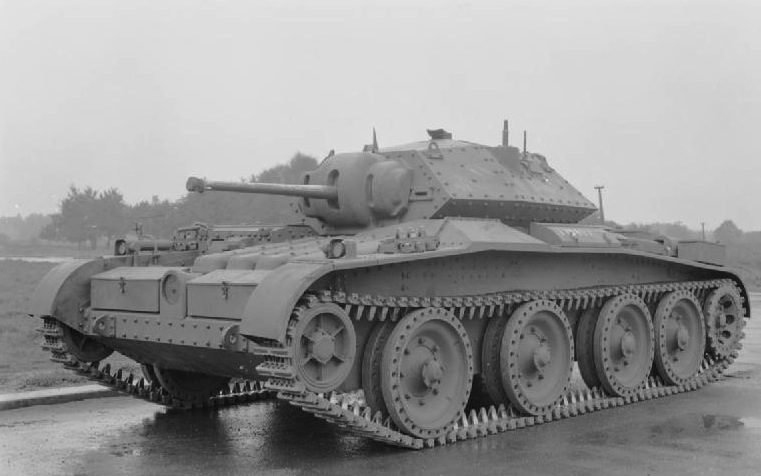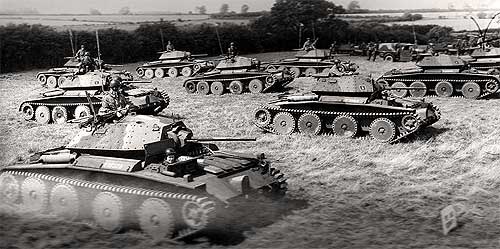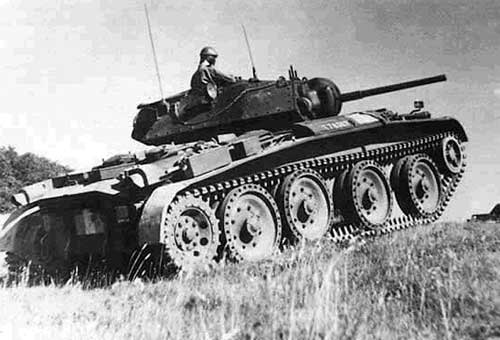
Cruiser tank "Covenanter"
Cruiser tank "Covenanter"Covenanter Tank Cruiser.
Like its predecessor, the Covenanter tank had five rubber-coated road wheels per side, rear-mounted drive wheels and a relatively low hull, armored sheets of which were connected with rivets. Armament in the form of a 40-mm cannon and a coaxial 7,92-mm machine gun was located in a low tower, the armor plates of which had large angles of inclination. The Mk V had good armor for its time: the frontal armor of the hull and turret was 40 mm thick, and the side armor was 30 mm thick. The vehicle was in production for a relatively short time, and after the production of 1365 units, it was replaced in production by the cruiser tank Mk VI "Crusider" with stronger armor. The Covenanters were in service with the tank brigades of the armored divisions. After his trip to Russia in 1936, Lieutenant Colonel Martel, assistant director of the Directorate of Motorization, proposed, in addition to cruising, a medium tank with armor up to 30 mm thick and high speed, capable of independent action. This was the result of his acquaintance with the T-28, which was in service in the USSR in fairly large numbers and was created under the influence of the British 16-ton tank of 1929, developed on the same basis. Tactical and technical requirements were drawn up, a large-scale layout was built, and in the end it was decided to build two experimental models with a three-man turret but with simplified requirements of the General Staff.
They received the designations A14 and A15 (later A16), respectively. Landon-Midden and Scottish Railway built the first model according to the plan worked out by the chief quartermaster of the Tank Development Directorate. The car had a Horteman-type suspension, side screens, a V-shaped 12-cylinder Thornycraft engine and a newly developed planetary transmission. The A16 was assigned to Nafield, which impressed Martel with the rapid development of the A13 tank. The A16 actually looked like a heavier modification of the A13. The layout and turrets of the A14 and A16 were similar to those of the A9/A10 series.
In the meantime, as a temporary measure, the A9 armor was brought up to 30 mm (so it became the A10 model), and the A14 and A16 were already created according to the requirements for medium (or heavy cruising) tanks. Tests of the A14 in early 1939 showed that it was too noisy and mechanically complex, as was the prototype A13 with the same armor thickness. Then KM5 was offered to stop working on the A14 cash and start improving the A13 - the A13 M1s 111 project. It was about maximizing the use of the A13 components and assemblies, but with the task of keeping the armor thickness to 30 mm, reducing the overall height of the machine. In April 1939, a wooden model of the tank was presented to the customer.
To reduce the height of the vehicle profile, the Flat 12 Meadows engine (a modification used on the Tetrarch light tank) and the Wilson double planetary transmission (used on the A14) were used. Compared to the A13 Mk II - or the Mk IV cruiser tank - the driver's seat was moved to the right, and the engine radiator was placed on the left in front of the hull. The first production models were delivered in early 1940, but they did not meet the requirements due to cooling problems that led to frequent shutdowns of the overheated engine. Various modifications to the machine were required, but the design problems were never overcome. A less serious task was to reduce the specific pressure on the ground due to excess weight.
In the middle of 1940, the tank received an official name. "Covenanter" in accordance with the British practice of designating combat vehicles introduced at that time. The total production of Covenanter tanks amounted to 1771 vehicles, but they were never used in combat, although until 1943 they were used in divisions based in the UK as training ones. Some vehicles were sent to the Middle East in the same capacity, others were converted into tank bridge layers. Work on the A14 and A16 practically ceased at the end of 1939 before the second prototypes of each type were assembled. Performance characteristics
Modifications to the Covenanter cruising tank:
Sources:
|
 The Covenanter tank was developed by Nuffield in 1939 as a result of long-term work on the development of technical solutions incorporated in the machines of the American designer Christie. Unlike the Soviet designers, who developed the original wheeled-tracked version of the Christie tank in the BT series, the British designers from the very beginning developed only the tracked version. The first vehicle with a Christie-type undercarriage was put into production under the name “Cruiser tank Mk IV” in 1938 and was produced until 1941. The armor protection of this fast tank was considered insufficient and after the production of 665 vehicles of this type, the cruiser Mk was put into production. V "Covenanter".
The Covenanter tank was developed by Nuffield in 1939 as a result of long-term work on the development of technical solutions incorporated in the machines of the American designer Christie. Unlike the Soviet designers, who developed the original wheeled-tracked version of the Christie tank in the BT series, the British designers from the very beginning developed only the tracked version. The first vehicle with a Christie-type undercarriage was put into production under the name “Cruiser tank Mk IV” in 1938 and was produced until 1941. The armor protection of this fast tank was considered insufficient and after the production of 665 vehicles of this type, the cruiser Mk was put into production. V "Covenanter".



